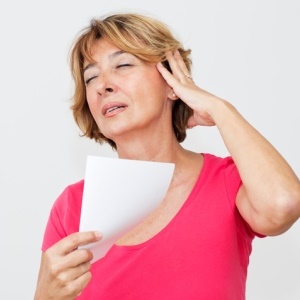
About 75-80% of women are affected by hot flushes – one of the most common symptoms of menopause.
Hot flushes (or flashes) generally start during the menopause transition, the period before the actual menopause (when you’ve completely stopped menstruating). Once you’ve reached menopause, you may continue to have hot flushes.
Research shows that hot flushes are often linked to poor quality of life, including sleep disturbances, anxiety, depression and reduced cognitive function (e.g. forgetfulness, difficulty concentrating).
What is a hot flush?
A hot flush is a feeling of intense heat, not caused by external sources. These flushes can appear suddenly, or you may feel them coming on.
You may experience:
- Tingling in your fingers
- Your heart beating faster than usual (heart palpitations)
- Your skin feeling suddenly warm
- Your face and/or chest getting red or flushed
- Sweating, especially in the upper body
A hot flush generally lasts less than five minutes, and the sweating that accompanies the flush usually starts a minute after experiencing heart palpitations. It may be followed by a chill, and some women feel anxious.
How often and when do hot flushes occur?
The frequency may range from one or two flushes per day to one every 15–30 minutes. Hot flushes tend to be more pronounced late in the day, during hot weather, after ingestion of hot foods or drinks, or during periods of stress and tension.
If thoughts about the general troubles of life don’t keep you awake at night, hot flushes might. In turn, this could lead to fatigue, anxiety and depression. Hot flushes accompanied by sweating during sleeping hours are called night sweats.
Hot flushes can begin during the menopause transition (the
perimenopause), before menstruation stops. Most women have hot flushes for more
than a year, while 25–50% will suffer for up to five years (or longer) if
they’re not treated.
What causes hot flushes?
It’s not exactly clear what causes hot flushes, but they’re most likely due to hormonal changes in the body. Some women barely notice them or consider them a minor annoyance. For others, the intensity may have a pronounced effect on their quality of life.
Interestingly, new research is linking hot flushes to inflammation in the body, which is likely triggered by the decline of hormones such as oestrogen. This could explain the increased risk for cardiovascular disease and osteoporosis that coincides with this life event.
Previous studies
also indicated that many women who experience hot flushes also have an impaired
lipid profile (a risk factor for cardiovascular disease), endothelial dysfunction
(i.e. the inner lining of the blood vessels don’t function as they should), increased
atherosclerosis (a disease characterised by fatty deposits on the inner artery
walls) and insulin resistance (which could lead to diabetes) during the
menopause period.
Home treatment of hot flushes
If you experience hot flushes, the following tips could be helpful:
- Keep your home and workplace cool.
- Wear loose clothing in layers that are easily removed. Choose natural fibres.
- Drink plenty of fresh, cool water.
- Avoid caffeine, alcohol, hot drinks and spicy foods if they bring on hot flushes.
- Exercise daily to help stabilise hormones and insulin levels. Although hot flushes can occur during exercise, regular exercise can help beat flushes and relieve insomnia.
- Avoid confined spaces and hot, humid weather.
- Keep a journal about your symptoms. Write down what you were doing, eating, drinking, feeling, or wearing when each hot flush began. After several weeks, you may begin to see a pattern that can help you to avoid specific triggers.
Home treatment for night sweats
- Wear light pyjamas.
- Sleep under a sheet and/or a light blanket (not a thick duvet).
- Have a brief shower if you wake up drenched.
Medication
About one in four women suffers from such severe hot flushes that they need menopause hormone therapy (MHT). MHT is the most effective treatment for menopausal symptoms.
The proposed mechanism of action of oestrogen therapy is that it ameliorates hot flashes by raising the core body temperature sweating threshold. Antidepressants are recommended as a first-line treatment for hot flushes in women who can’t take oestrogen. Talk to your doctor about your options.
Alternative therapies
Acupuncture may be helpful, and comes without the side effects of medication. A small study found that women who had acupuncture had significantly fewer menopausal symptoms, including hot flushes, than those who had sham treatments. Sham acupuncture is shallow needling that doesn’t stimulate a true acupuncture point.
Meditation can also be very successful in helping manage stress levels. Stress is a common hot-flush trigger for many women.
Reviewed and updated by Dr Carol Thomas MBChB (UCT) FCOG (SA) MMed (O&G) (UCT), specialist gynaecologist in private practice, Cape Town, President of the South African Menopause Society and Director of the WomanSpace and iMobiMaMa. (March 2017)
Image credit: iStock




 Publications
Publications
 Partners
Partners











